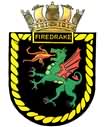 |
|
Able
Seaman
Dennis Andrews |
Dennis at HMS Ganges |
Able
seaman Dennis G. Andrews who was 20 years old when he was lost with
HMS Firedrake in December 1942. Earlier that year Dennis was on board HMS Cornwall when it was bombed and sunk on April 5th 1942, he was rescued after 36 hours in the sea (see attached telegram reporting him missing and the cable from Dennis saying he was OK after his rescue). He was married that same year (see attached photo) and was on leave when he was called to serve on the Firedrake due to a crew member being absent. He was lost with HMS Firedrake when she was torpedoed and sunk in December 1942. |
|
|
|
| Photo above: The telegram reporting Dennis missing with HMS Cornwall. | Photo above: The cable sent by Dennis saying he was OK when HMS Cornwall had sunk. |
|
|
|
| Photo above: Dennis and Barbara on their wedding day soon after he had survived the sinking of the Cornwall. | Photo above: The telegram reporting Dennis missing when the Firedrake was sunk. |
|
|
Bert
How
Remembers |
|
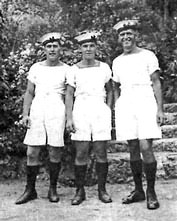 |
My
name is Bert How, I’m the one in the middle of the photo
on the left, Knobby Clark my mate survived the war but passed away
in February 2001 after a long illness, but poor Nazzer he went down
with the Firedrake in 42. Anyway I joined the Navy as an HO (Hostilities
Only) at Royal Author Skegness in April 1940. And then to Chatham for more training, I joined the Firedrake in the August as an Asdic rating, she had just come back from the second battle of Narvik there were shrapnel holes every where, but it wasn’t long before we were off on operation Hats the reinforcement of naval personnel to the Eastern Mediterranean with Force H and Admiral Somerville. We saw action at the battle of Spartivento, the battle with the Italian fleet, we were at the shelling of Genoa and we did several convoys to Malta and to the UK, we had some very close calls the Italian and German dive bombers came in very close. |
| We sank
the Italian submarine Durbo after taking her crew prisoner. We stopped
a couple of merchant ships and searched them for contraband and did
a lot of patrolling. In the March of 1941 we ran aground off Gibraltar while on patrol in thick fog, we manage to get the ship off the rocks by using the anchor and winding the ship back off the rocks using the capstan, I was one of those who had to work the capstan, there wasn’t much damage but we had lost our ASDIC dome so that meant we had to go back to Chatham for repairs, we soon returned to the Med for more convoy escort duties. |
|
In the July we were on operation Substance a convoy to Malta, when we got badly damaged by an Italian bomb that just missed us, good job it did, the damage was immense there was a massive hole in our starboard side and stopped our engines, we had some very tense moments trying to get the engines running again, we got a tow by the Eridge for part of the way to Gib, but it was slow going, on the way back force H passed us on there way back to Gib after delivering the convoy to Malta, Admiral Somerville had issued an order to all the ships in the force to cheer the Firedrake as they went passed, which they all did with all there ships company’s on there decks it was a great site, when we got to Gibraltar we had temporary repairs done then made our way to America for major repairs and refit. |
| We
docked at Boston Massachusetts. We got a lot of time off while the
repairs were being carried out, the Americans had a scheme running
that enabled the civilians to report at the dock gates and take a
couple of us home or out for the night or a couple of days we used
to call them the Barons, we got to go to shows that we wouldn’t have
been able to afford otherwise. One of our lads Douglas Farren ended up on the stage singing with Diana Durban, who was a very big star of stage and screen, he was a very musical chap and could make a tune out of any thing, he used to play the spoon’s, he was a very good singer. Sadly Douglas was lost with Firedrake a year later. |
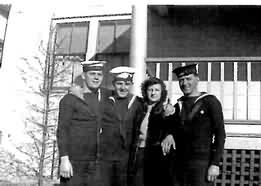 |
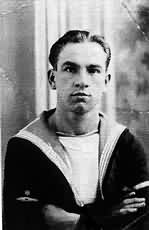
|
The
photo above right: was taken in Boston over the Christmas period
1941 at one of the houses of the Barons who used to welcome the
Firedrake crew. |
|
I lost many good mates and often think of them today. I then joined HMS Musketeer and was on Russian convoys, I stayed with that ship till the end of the war. Bert How remembers staying with two families in Boston Mr & Mrs Cotton and Mr & Mrs Smith, after the war Mr & Mrs Cotton came over to visit Bert at his home in London. |
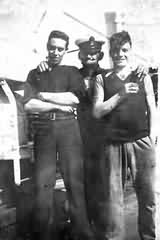
|
Bill
Aldous that's me the handsome one on the left, with two of my
shipmates. When I was with the Firedrake I saw action in the Atlantic, North Sea and Mediterranean where we sunk the Italian Sub "Durbo". We were at the battle of Spartivento against the Italian fleet , shelled Genoa, and ran aground off Spain, was badly damaged by Italian bombers when on operation substance a convoy to Malta which meant we had to go to America for repairs. |
| The Americans looked after us very well, and used to take us to shows and wined and dinned us, I was there when the Japanese bombed Pearl harbour, up till then the Americans would have preferred to have kept out of the war, but at the same time of the Japanese attack, the Germans declared war on America so they were in it whether they liked it or not. |
| After Firedrake was repaired we resumed convoy duties again across the Atlantic with B7 escort group out of Londonderry to America and Canada, Halifax St Johns, Newfoundland. I wasn't on Firedrake's last duty, I was on another S.D. course. So I was drafted to HMS Harrier (Fleet Mine sweeper) her duties were mine sweeping on Russian Convoys to Murmansk and Archangel and sweeping invasion troops ashore on D-day after the invasion we were kept busy clearing mines from around channel ports. |
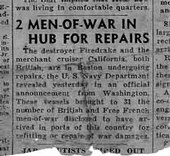 |
I then joined HMS Calder for three months on Atlantic patrols in that time we contacted and sunk one U-boat, by this time we had got on top of the U-boat threat and were winning the war in the Atlantic. Then I joined M.L. 915 and moved into the German port of Coxhaven and patrolled till the army arrived, I stayed with ML 915 till the end of the war, being demobed at HMS Osprey 26/1/46. |
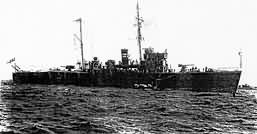 HMS Harrier |
| News Cutting on the left: was cut from a Boston News Paper by Bill when he was in Boston with the Firedrake having the bomb damage repaired in 1941. |
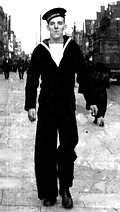 |
Photo
Left: John Lawley photographed on Barking Road, Canning Town, East London, 1940. John was the eldest of eight children, two of his brothers also served aboard ships in world war two, one in the Navy the other as a marine. John made friends with the Stanley family in Boston U.S.A. when the Firedrake was there for repairs in 1941. John was drafted to another ship in 1942, and survived the war, but sadly died after emigrating to Australia in the sixties. |
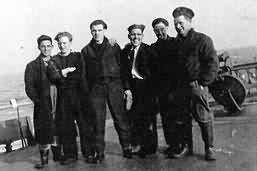 Photo above: Taken in Halifax Nova Scotia, January 1942. Names below from left to right. |
| 1. Nicknamed
Niger was lost with the Firedrake. 2. Charlie Ireland P.O. Cook from Sherringham Norfolk was also lost. 3. Name unknown a torpedo man I think. 4. Ernie Read was transferred to another ship so survived. 5. Jock D.B.Christison Ldg Steward was also lost. He was head waiter at St Andrews Golf Club Scotland. 6. Fred Pope was also lost. He'd been Mentioned in Dispatches when Firedrake sunk the Durbo. |